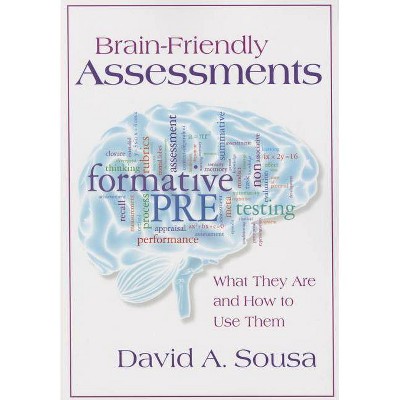How the Brain Learns Mathematics - 2nd Edition by David A Sousa (Paperback)

Similar Products
Products of same category from the store
AllProduct info
<p/><br></br><p><b> About the Book </b></p></br></br><p><strong><em>To reach all your math students, use your brain--and theirs, too!</em></strong></p> <p>This updated bestseller takes readers to the next level with new brain-friendly strategies backed by the latest research and even more ways to seamlessly incorporate what you learn about your students' developing minds into your math classroom. Discover the cognitive mechanisms for learning math, explore factors that contribute to learning difficulties, and follow a four-step teaching model that relates classroom experience to real-world applications. Features include: </p> <p> </p> <ul> New strategies for motivating adolescents</li> Integration of the arts into mathematics instruction</li> New information on how technology affects attention and memory</li> Expanded sections on number sense and ELL instruction</li> More than 160 new references</li> </ul><p/><br></br><p><b> Book Synopsis </b></p></br></br><p><strong><em>To reach all your math students, use your brain--and theirs, too!</em></strong></p> <p>This updated bestseller takes readers to the next level with new brain-friendly strategies backed by the latest research and even more ways to seamlessly incorporate what you learn about your students' developing minds into your math classroom. Discover the cognitive mechanisms for learning math, explore factors that contribute to learning difficulties, and follow a four-step teaching model that relates classroom experience to real-world applications. Features include: </p> <p> </p> <ul> New strategies for motivating adolescents</li> Integration of the arts into mathematics instruction</li> New information on how technology affects attention and memory</li> Expanded sections on number sense and ELL instruction</li> More than 160 new references</li> </ul><p/><br></br><p><b> Review Quotes </b></p></br></br><br><em>Few other books discuss the scientific way the brain is mathematically wired while maintaining relevance to those interested in K-grade 12 education. Readers can expect to gain a deeper understanding of why students learn certain concepts easily and struggle with others and why the battle for successful student learning in mathematics is ever-changing. This book is not merely a collection of lesson plans and activities; it is also a deeper investigation into the science of mathematical learning and inspires readers to continue their own learning into the fascinating world of education. </em>--Nikki Armstrong, Mathematics Teacher<br><br><em>Teaching mathematics without having </em><em>read <strong>How the Brain Learns Mathematics</strong> is like trying to master tennis without a coach. Sousa′s book is a tour de force: It builds a solid bridge from cognitive neuroscience to daily classroom practice. Every teacher of mathematics will benefit from this well-researched, well-organized, thoughtful, and practical approach to making math instruction align with how brains learn.</em>--Spencer Kagan., Publisher/Professional Developer (8/14/2014 12:00:00 AM)<br><br><p><em>David Sousa has done it again! He has produced a highly-relevant, exceptionally practically, research focused book that will build better mathematics brains in classrooms and schools.</em></p>--John T. Almarode, Assistant Professor of Education<br><br><p><em>David Sousa's </em>How the Brain Learns Mathematics, Second Edition<em> is a wonderfully readable presentation of how neuroscience and cognitive psychology can inform the teaching of mathematics in elementary and secondary schools. Sousa engages his readers intellectually with recent research on the brain and mathematics learning, and avoids pat answers where the evidence is suggestive rather than conclusive. The book should be a valuable text for teachers who want a deeper insight into thinking processes behind the learning and teaching of math.</em></p>--Robert E. Slavin, Director<br><br><p><em>Sousa nailed it with these powerful insights on mathematics instruction. Teachers simply have to understand how students learn in order to provide top-notch instruction, and the specific teaching suggestions herein are invaluable! I love the three tier structure, emphasizing differences in teaching Pre-K and K, Pre-adolescent brains, and adolescent brains, and the emphasis on number sense at all levels is essential in the classroom today. Math teachers will apply these critical lessons immediately in their classes, and I'd urge every mathematics teacher and every elementary teacher to get this book!</em></p>--William N. Bender, Author and Educational Consultant<br><br>From a review in NCTM's<em> Mathematics Teaching in the Middle School</em> <br/> <em>Classroom teachers, administrators, and math coaches will appreciate the research-based explanations for why mathematics instruction that focuses on meaning making, connections, and processes is so important. </em>--Mary Alice Carlson<br>
Price History
Price Archive shows prices from various stores, lets you see history and find the cheapest. There is no actual sale on the website. For all support, inquiry and suggestion messagescommunication@pricearchive.us




















